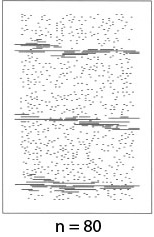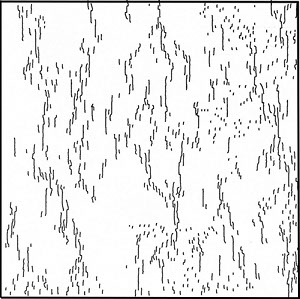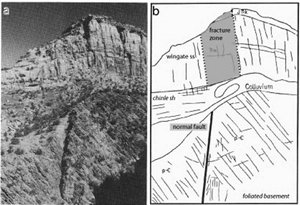| |||||||||
|
|
|||||||||
|
|
|||||||||
| Mechanisms and Mechanics of Joint Zones | |||||||||
|
Two important factors which play an important role in joint zone formation are joint propagation velocity and joint interaction. Joint propagation velocity has been considered earlier and has been linked to subcritical index, the higher values of which result in localization of joints into distinct zones. For example, Figure 1 is a pattern produced by a numerical fracture mechanics model with a subcritical index value of 80 (Olson, 2004). Figure 2 illustrates a somewhat different joint pattern with joint zones with echelon joint architecture (Renshaw and Pollard, 1995) reflecting the influence of joint interaction on the joint alignment to form a zone (Du and Aydin, 1991).
There are, of course, other means of producing joint localization. Strain localization around the tip areas of large scale structures (process zones and damage zones) and above buried faults may be considered in this category. Figure 3 shows joint and sheared joint localization into a well-defined zone in the Mesozoic Wingate Sandstone and Kayenta Formation above a basement normal fault in the Colorado Plateau. In the figure, the fracture zone in the cover above the basement fault has been highlighted for emphasis. From a similar perspective, a layer or formation or region with a significantly higher joint density than its surroundings may be referred to as a joint zone. | |||||||||
| Reference: |
|||||||||
| Du, Y., Aydin, A., 1991 Heyman, O.G., 1983 Kelly, P.G., Sanderson, D.J., Peacock, D.C.P., 1998 Olson, J., 2004 |
|||||||||
|
Readme | About Us | Acknowledgement | How to Cite | Terms of Use | Ⓒ Rock Fracture Knowledgebase |
|||||||||


